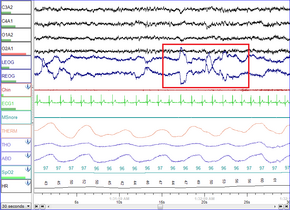Polysomnographies
| Polysomnography | |
|---|---|
| Medical diagnostics | |

Polysomnographic record of REM sleep. Eye movements highlighted by red rectangle.
|
|
| ICD-9-CM | 89.17 |
| MeSH | D017286 |
| OPS-301 code | 1-790 |
| MedlinePlus | 003932 |
| LOINC | 28633-6 |
Polysomnography (PSG), a type of sleep study, is a multi-parametric test used in the study of sleep and as a diagnostic tool in sleep medicine. The test result is called a polysomnogram, also abbreviated PSG. The name is derived from Greek and Latin roots: the Greek πολύς (polus for "many, much", indicating many channels), the Latin somnus ("sleep"), and the Greek γράφειν (graphein, "to write").
Polysomnography is a comprehensive recording of the biophysiological changes that occur during sleep. It is usually performed at night, when most people sleep, though some labs can accommodate shift workers and people with circadian rhythm sleep disorders and do the test at other times of day. The PSG monitors many body functions including brain (EEG), eye movements (EOG), muscle activity or skeletal muscle activation (EMG) and heart rhythm (ECG) during sleep. After the identification of the sleep disorder sleep apnea in the 1970s, the breathing functions respiratory airflow and respiratory effort indicators were added along with peripheral pulse oximetry.
Polysomnography is used to diagnose, or rule out, many types of sleep disorders including narcolepsy, idiopathic hypersomnia, periodic limb movement disorder (PLMD), REM behavior disorder, parasomnias, and sleep apnea. Although it is not directly useful in diagnosing circadian rhythm sleep disorders, it may be used to rule out other sleep disorders.
...
Wikipedia
